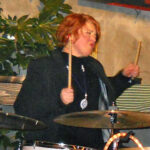In recent weeks, the vibrant indigo bunting has become a constant serenade in my surroundings. This small, sparrow-sized songbird, particularly the male with its striking indigo plumage, has been remarkably vocal. While females sport a more subdued warm beige, with a hint of blue on their tails during the summer months, it’s the males’ persistent singing that truly captures attention. Living amidst a blend of cornfields and woods, the indigo buntings’ songs seem to fill the air at all hours.
Perhaps it’s the shift in the avian soundscape as August progresses, with other birdsong becoming less frequent, that makes the bunting’s repetitive, squeaky phrases stand out. Yet, there’s no denying their enthusiastic singing. As I write this, relaxing on my front porch, their melodies are clearly audible. Cornell Lab aptly describes their dedication, noting they “often sing for hours on end.”
This particular song was not part of my childhood soundscape. Indigo buntings were scarce in the heavily wooded areas where I grew up. These birds favor open habitats interspersed with trees – think orchards, brushy meadows, or the edges of farm fields. It wasn’t until field trips with the Ralph T. Waterman Bird Club that I first encountered the dazzling blue of an indigo bunting, likely in a place like Vassar Farm.
In bird books, the indigo bunting seemed almost mythical, much like its North American relatives, the lazuli bunting (western US) and the painted bunting (southern US). The painted bunting, with its riot of purple, red, and lime green, was an even greater revelation when I spotted a flock in Big Bend National Park, Texas, nestled in a grassy, shaded area near the Rio Grande.
Experienced birders from the club helped me decipher their song: a series of paired notes, typically seven or eight, each pair slightly descending in pitch. It’s often described as a thin, “Lazy Song” due to its seemingly simple and unvaried nature. However, Cornell Lab reveals a hidden complexity: “buntings a few hundred yards apart generally sing different songs, while those in the same ‘song neighborhood’ share nearly identical songs. A local song may persist up to 20 years, gradually changing as new singers add novel variations.” This “lazy song,” therefore, is not as simple as it first appears, holding within it a fascinating element of local culture and evolution.
Later, I discovered indigo buntings closer to home near Hopewell Junction. Exploring the Lomala area, venturing off the beaten paths of streets onto the railroad tracks, into powerline clearings, and into the floodplain forests along the creek, I found their preferred habitat. Near the powerlines, a secluded field, otherwise enclosed by woods, provided the perfect open space. This, combined with the powerline corridor, was enough to attract birds that thrive in clearings: indigo buntings, field sparrows, prairie warblers, and blue-winged warblers. Although this field is gradually reverting back to forest, with shrubs and trees taking hold, it remains a remarkable, almost secret, pocket of habitat, and a haven for these birds drawn to open spaces and their characteristic “lazy song”.
Now, surrounded by rural landscapes, indigo buntings are a frequent sight. They perch prominently on roadside trees, singing their hearts out before darting into the cornfields, sometimes even choosing the top of a swaying cornstalk as their stage.
Indigo buntings are more easily observed than many other songbirds. Beyond their preference for open habitats, they tend to select high perches and remain there while singing, unlike more elusive birds that flit through the undergrowth. Once you discern their “lazy song,” spotting them high on a branch tip is usually straightforward.
The brilliant indigo color, however, can be deceiving. Unless bathed in direct sunlight, they often appear dark, almost silhouetted against the sky. Cornell Lab explains this fascinating phenomenon: “Like all other blue birds, Indigo Buntings lack blue pigment. Their jewel-like color comes instead from microscopic structures in the feathers that refract and reflect blue light, much like the airborne particles that cause the sky to look blue.” This structural coloration is what gives them their jewel-toned appearance, a visual complement to their unique “lazy song.”
Indigo buntings are relatively abundant and widespread across the Eastern and Central U.S. They arrive around mid-May, migrating from their wintering grounds in Central America, where they unfortunately face threats from hunting and capture as cage birds. While they might visit backyard feeders, especially those offering thistle or nyjer seed, the best way to appreciate them is along sunny country roads. Scan the treetops, listen for that squeaky, “lazy song,” and you’ll likely discover this tranquil and brilliantly colored songster.
Based on the original article by Kateri Kosek, a member of the Waterman Bird Club.

